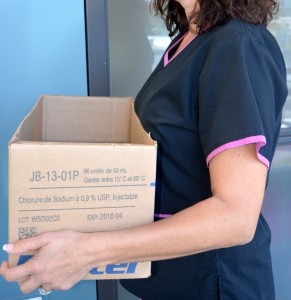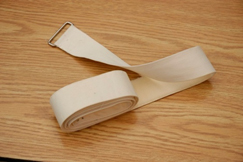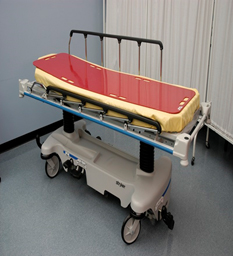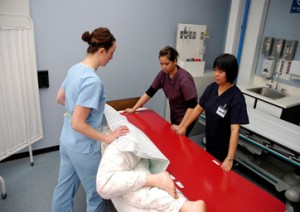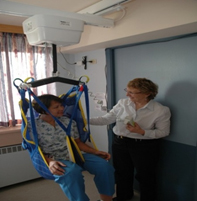Chapter 3. Safe Patient Handling, Positioning, and Transfers
3.2 Body Mechanics
Body mechanics involves the coordinated effort of muscles, bones, and the nervous system to maintain balance, posture, and alignment during moving, transferring, and positioning patients. Proper body mechanics allows individuals to carry out activities without excessive use of energy, and helps prevent injuries for patients and health care providers (Perry, Potter, & Ostendorf, 2014).
Musculoskeletal Injuries
A musculoskeletal injury (MSI) is an injury or disorder of the muscles, tendons, ligaments, joints or nerves, blood vessels, or related soft tissue including a sprain, strain, or inflammation related to a work injury. MSIs are the most common health hazard for health care providers (WorkSafeBC, 2013). Table 3.1 lists risk factors that contribute to an MSI.
|
Factor |
Special Information |
||
| Ergonomic risk factors | Repetitive or sustained awkward postures, repetition, or forceful exertion | ||
| Individual risk factors | Poor work practice; poor overall health (smoking, drinking alcohol, and obesity); poor rest and recovery; poor fitness, hydration, and nutrition | ||
| Data source: Perry et al., 2014; Workers Compensation Board, 2001; WorkSafeBC, 2013 | |||
When health care providers are exposed to ergonomic risk factors, they become fatigued and risk musculoskeletal imbalance. Additional exposure related to individual risk factors puts health care providers at increased risk for an MSI (WorkSafeBC, 2013). Preventing an MSI is achieved by understanding the elements of body mechanics, applying the principles of body mechanics to all work-related activities, understanding how to assess a patient’s ability to position or transfer, and learning safe handling transfers and positioning techniques.
Elements of Body Mechanics
Body movement requires coordinated muscle activity and neurological integration. It involves the basic elements of body alignment (posture), balance, and coordinated movement. Body alignment and posture bring body parts into position to promote optimal balance and body function. When the body is well aligned, whether standing, sitting, or lying, the strain on the joints, muscles, tendons, and ligaments is minimized (WorkSafeBC, 2013).
Body alignment is achieved by placing one body part in line with another body part in a vertical or horizontal line. Correct alignment contributes to body balance and decreases strain on muscle-skeletal structures. Without this balance, the risk of falls and injuries increase. In the language of body mechanics, the centre of gravity is the centre of the weight of an object or person. A lower centre of gravity increases stability. This can be achieved by bending the knees and bringing the centre of gravity closer to the base of support, keeping the back straight. A wide base of support is the foundation for stability. A wide base of support is achieved by placing feet a comfortable, shoulder width distance apart. When a vertical line falls from the centre of gravity through the wide base of support, body balance is achieved. If the vertical line moves outside the base of support, the body will lose balance.
The diagram in Figure 3.1 demonstrates (A) a well-aligned person whose balance is maintained and whose line of gravity falls within the base of support. Diagram (B) demonstrates how balance is not maintained when the line of gravity falls outside the base of support, and diagram (C) shows how balance is regained when the line of gravity falls within the base of support.
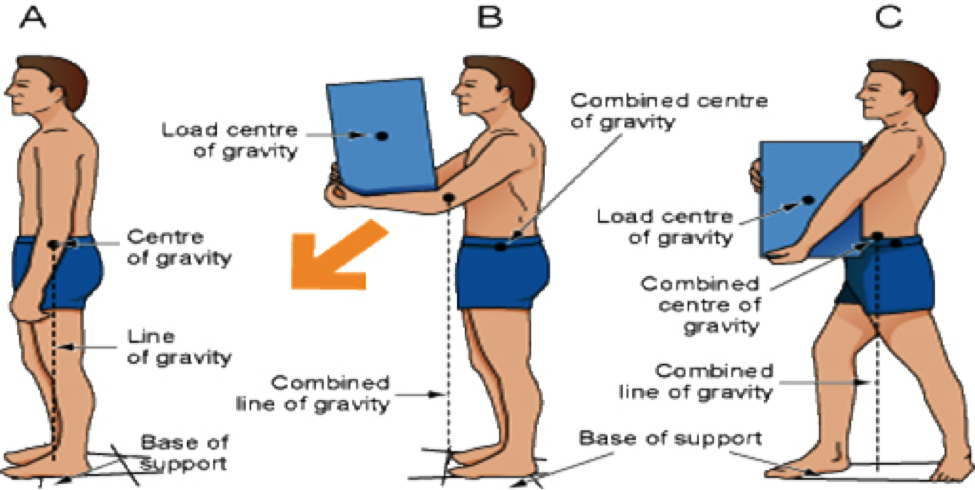
Principles of Body Mechanics
Table 3.2 describes the principles of body mechanics that should be applied during all patient-handling activities.
Assistive Devices
An assistive device is an object or piece of equipment designed to help a patient with activities of daily living, such as a walker, cane, gait belt, or mechanical lift (WorkSafeBC, 2006). Table 3.3 lists some assistive devices found in the hospital and community setting.
Video 3.1
Special considerations:
- Use assistive devices only if properly trained in their safe use.
- Always tell patients what you are about to do and how they should assist you in the procedure.
- Always perform a patient risk assessment or mobility assessment prior to using any assistive devices. The following link provides additional information regarding assistive devices from WorkSafeBC.
- Use proper body mechanics when using assistive devices.
Critical Thinking Exercises
- How do body alignment and body balance contribute to proper body mechanics?
- John is asked to lift a heavy box from a table onto a trolley. Name five principles of body mechanics John can implement to prevent an MSI.

